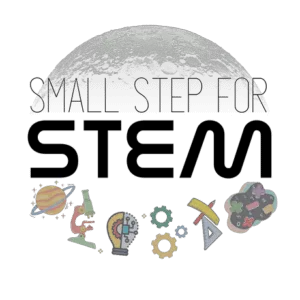During my decade of work at NASA’s Johnson Space Center in Houston, I worked on many STEM projects, including teaching children about NASA and Earth Science. If you want to know more about what I’ve done at NASA, keep reading.
Now, I have two small kids of my own and hope to get them as excited as I am about STEM subjects. Through play, experiments, and life lessons, we’re going to tackle as many of the elements of STEM as possible to gear my daughters up for STEM success.
I started Small Step for STEM to empower you to empower your child’s creativity and curiosity. Filled with information and fun experiments, you will walk away ready to teach your child all about science, math, engineering, and technology using age-appropriate experiments!
I hope you join me and incorporate some of these fun experiments into your own play with your children! Even if you know nothing about STEM subjects, I’m here to guide you and help you confidently teach your kids.
Let’s go through this fun experience together!
My experience with STEM
I’m extremely lucky. Well, some of it has to do with luck. Part of it was a lot of hard work and dedication to STEM.
I saw my first Shuttle launch when I was in the third grade. We took a class trip over to Kennedy Space Center and that evening Shuttle launch rocked my world. Since that moment, I knew I wanted to work at NASA.
I picked up a couple of internships at NASA while in college. One at Goddard Spaceflight Center and one at Johnson Space Center (JSC). I knew JSC was where I wanted to be (get to work alongside astronauts? Yes, please!).
The day of graduation came and I had applied to JSC for a job. I waited, rather impatiently, to get a call back. And one day, it happened: I was offered a job at NASA.
From my internships to a permanent position to my move up to management, I spent a decade working at NASA. I taught astronauts, as well as kids, about STEM.
Here are a few projects I worked on that touched on STEM:
S – Science
I earned a degree at the University of Oklahoma (Boomer Sooner!) in Meteorology and Physics, with a minor in Mathematics. I used that degree to teach astronauts and Mission Directors all about Earth Science and work with scientists around the world observing and studying the Earth from space.
My desk was in the same building that houses geology samples taken from space, including all of the lunar rocks picked up during the Apollo missions. Because of that, I worked with many geologists who handle these lunar samples.
In addition, I worked with scientists all around the world who needed imagery taken of their research site from the vantage point of space.
T – Technology
I designed and coded the website that houses millions of astronaut photographs of the Earth and is made available (for free!) to the public. These photographs start at the first missions of Mercury, Gemini, and Apollo and range to images taken today on the International Space Station.
If you want to check it out, just look up “Gateway to Astronaut Photography of Earth”.
One other fun project I worked on was to create an interactive journey of Apollos 15, 16, and 17 lunar rover treks. Along each rover trek, you can view the lunar samples picked up along with all of the data recorded by the geology team.
E – Engineering
Since Johnson Space Center is comprised of mostly engineers, I was able to experiment with many of the engineering projects underway at the Center, including:
- “flying” through the International Space Station with virtual reality
- riding in a lunar rover built at JSC
- experimenting in ISS modules
- “flying and landing” a Space Shuttle simulator
All the while, learning the engineering behind these amazing experiences!
M – Math
Using my Mathematics minor, I enjoyed writing formulas for calculating the correct angles the astronauts should look to photograph a very specific spot on Earth.
There are a lot of moving parts to take into account: the International Space Station is 250 miles up, flying at a speed of about 17,500mph, and the astronauts have a tiny window to look out of to photograph moving targets. Not only that, but the targets we asked them to photograph might not be directly under the Station’s path, making it even more challenging!
On the other end of the spectrum: I did move into Project Management eventually, where I kept a detailed budget for our group.
What you can expect from Small Step for STEM
I plan on building a database of fun experiments to do with your kids that touch on most if not all, areas of STEM.
I will be doing these experiments with my own kids, who were 1 and 3 when I started this website, and build upon them as the kids get older. There should be something for everyone in this database if you hang with me long enough!
If you have any questions along the way or just want to start a conversation, feel free to reach out to me. I’m here to help guide you in any way I can. I believe that STEM is important and valuable to everyone, and with the right tools at your disposal, anyone can incorporate it into their lives.
smallstepforstem (at) gmail (dot) com
